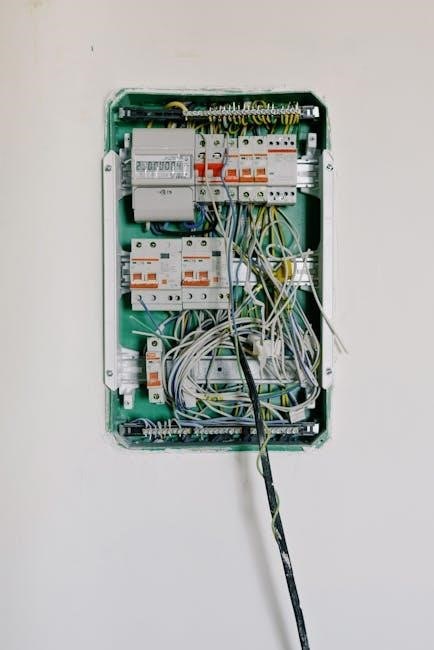A Phase-Locked Loop (PLL) is a feedback system synchronizing an oscillator with a reference signal, crucial in modern electronics for frequency and phase coherence. Used in wireless communications, digital systems, and signal processing, PLLs ensure stable operation across varying conditions, making them indispensable in today’s technological landscape.
Overview of PLLs and Their Importance
Phase-Locked Loops (PLLs) are fundamental components in modern electronic systems, enabling precise synchronization of signals. They are widely used in wireless communications, digital systems, and signal processing to maintain frequency and phase coherence. PLLs ensure stable operation by locking an oscillator’s output to a reference signal, minimizing noise and jitter. Their importance lies in their ability to enhance signal integrity, enabling reliable data transmission and processing. PLLs are versatile, operating in both analog and digital domains, and are critical for applications like clock recovery, frequency synthesis, and data synchronization. Their role in modern electronics underscores their significance in advancing communication and computing technologies.

Architecture of a Phase Locked Loop
A Phase-Locked Loop (PLL) consists of a phase detector, loop filter, and voltage-controlled oscillator (VCO). These components work together to maintain phase and frequency lock with a reference signal.
Key Components: Phase Detector, Loop Filter, and Voltage-Controlled Oscillator (VCO)
The core of a PLL consists of three essential components. The phase detector compares the phase of the reference signal with the feedback signal, generating an error signal proportional to the phase difference. This error is then processed by the loop filter, which adjusts the loop dynamics to ensure stability and optimal tracking performance. Finally, the voltage-controlled oscillator (VCO) generates the output signal, with its frequency controlled by the filtered error voltage. Together, these components enable the PLL to lock onto the reference signal, maintaining phase and frequency coherence. Each element plays a critical role in the loop’s operation and accuracy.
Working Principle of a PLL
A PLL operates as a feedback system, locking onto a reference signal’s frequency and phase. It adjusts the VCO’s output through the phase detector and loop filter, ensuring synchronization and coherence.
How the Loop Maintains Phase and Frequency Lock
The loop maintains phase and frequency lock by continuously adjusting the voltage-controlled oscillator (VCO) based on the phase difference between the reference and feedback signals. The phase detector compares these signals, generating an error signal proportional to their phase difference. This error signal is filtered by the loop filter to remove noise and high-frequency components, ensuring stability. The filtered signal then controls the VCO, adjusting its frequency and phase to match the reference input. This feedback mechanism ensures that the VCO remains synchronized with the reference, maintaining both frequency and phase lock over time.

Applications of Phase Locked Loops
Phase Locked Loops are essential in wireless communications, digital systems, signal processing, electronics, and telecommunications, enabling synchronization, clock recovery, and data recovery applications effectively and efficiently.
Use in Wireless Communications, Digital Systems, and Signal Processing
Phase Locked Loops (PLLs) are integral to wireless communications for clock recovery, frequency synthesis, and data synchronization, ensuring reliable data transmission. In digital systems, they generate stable clock signals, reduce jitter, and enable precise timing. PLLs also play a key role in signal processing for noise reduction, frequency locking, and timing recovery. Their ability to synchronize signals makes them indispensable in modern electronics, facilitating efficient operation across diverse applications.

Design Considerations for PLLs
Designing PLLs requires careful consideration of stability, noise reduction, and loop filter optimization to ensure reliable operation and precise phase locking in various applications.
Stability, Noise, and Filter Design
Stability in PLLs is crucial for maintaining reliable operation, ensuring the loop remains locked under varying conditions. Noise, both internal and external, can degrade performance, requiring careful filtering. The loop filter plays a key role in suppressing high-frequency jitter and stabilizing the system. Proper design ensures optimal phase margin and damping, preventing oscillations. Digital PLLs offer improved noise immunity and precision, while analog designs rely on passive components for filtering. Advanced techniques, such as adaptive filtering, enhance stability in dynamic environments. Balancing stability, noise reduction, and filter design is essential for achieving high-performance PLLs in modern applications.

Practical PLL Design Tutorial
Learn to design PLLs using MATLAB for simulation and analysis, ensuring stability and performance through loop equations and practical implementation techniques.
Using MATLAB for Simulation and Analysis
MATLAB is a powerful tool for designing and analyzing PLLs, enabling the creation of detailed models and simulations. Engineers can model transfer functions, analyze loop stability, and optimize filter parameters. The software allows for time-domain simulations to observe the PLL’s dynamic behavior, such as locking time and steady-state error. MATLAB also provides tools for calculating phase margin and damping, ensuring reliable performance. By simulating various scenarios, designers can validate their PLL designs and visualize results, making it an essential resource for both educational and professional applications in PLL development.
Advanced Topics in PLL Design
Digital PLLs (DPLLs) offer enhanced precision and flexibility, leveraging digital signal processing for improved noise immunity and programmability. Modern implementations integrate all-digital architectures, enabling applications in high-speed communication systems.
Digital PLLs and Modern Implementations
Digital Phase-Locked Loops (DPLLs) represent a significant advancement in PLL technology, leveraging digital signal processing for improved accuracy and flexibility. Unlike traditional analog PLLs, DPLLs utilize digital components such as Time-to-Digital Converters (TDCs) and Phase-Frequency Detectors (PFDs) to measure phase and frequency differences. This digital approach enhances noise immunity, enabling better performance in noisy environments. Modern implementations often integrate all-digital architectures, making them ideal for System-on-Chip (SoC) designs. DPLLs also offer programmability, allowing for dynamic adjustments in loop parameters. These features make digital PLLs indispensable in high-speed communication systems, wireless transceivers, and emerging applications requiring precise timing synchronization.
PLLs remain vital in modern electronics, enabling precise synchronization and noise reduction. Future trends include advanced digital implementations, adaptive architectures, and emerging applications in high-speed communication systems.
Phase-Locked Loops (PLLs) are indispensable in modern electronics, enabling precise synchronization and noise reduction. Their ability to lock onto a reference signal ensures stable operation in wireless communications, digital systems, and signal processing. Traditional applications include clock recovery in data transmission and frequency synthesis in radio systems. Emerging trends highlight PLLs in 5G networks, IoT devices, and AI hardware, where low jitter and high accuracy are critical. Researchers are also exploring adaptive PLL architectures for dynamic environments and energy-efficient designs. Additionally, PLLs are pivotal in automotive systems, such as ADAS, and in next-generation quantum technologies. Ongoing advancements promise to expand PLL applications, ensuring their relevance in future technological advancements.

